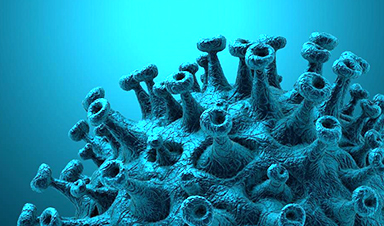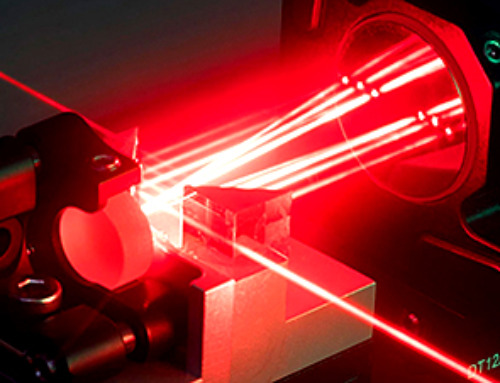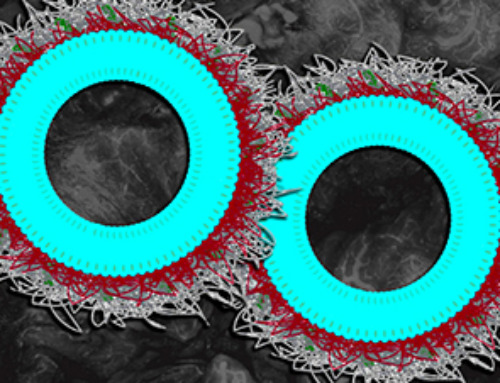A study recently published in the journal Infection, Genetics and Evolution explored the attachment affinity of carbon nanotubes (CNTs) and carbon nano-fullerene towards numerous molecular targets of severe acute respiratory syndrome coronavirus 2 (SARS-CoV-2).
Computational modeling of the 3D architectures of nano-fullerenes and CNTs was carried out, and molecule binding and molecular dynamic (MD) simulations were used to estimate the attachment affinity of the nanoparticles to the chosen target molecules. The research emphasizes the need of using carbon nanoparticles as a treatment for COVID-19.
COVID-19 Taking the World by Storm
The shocking COVID-19 epidemic attributed to Severe Acute Respiratory Syndrome Coronavirus-2 (SARS-CoV-2), first detected in Wuhan, China, in December of 2019, has since expanded globally. A virulent pathogen, SARS-CoV-2 belongs to the ß-coronavirus family and is a positive-stranded RNA virus. The spike glycoproteins that appear on the envelope give these pathogens a crown-like appearance. Other proteins in the viral structure include membrane and envelope proteins, nucleocapsid protein, and RNA dependent on RNA polymerase as structural proteins.
Inadequacy of Current Treatments
At first, anti-viral medications including remdesivir, lopinavir, chloroquine, and hydroxychloroquine were recommended for COVID-19 infection therapy. Recent assessments, however, proved the ineffectiveness of chloroquine and hydroxychloroquine when combatting SARS-CoV-2. Several drugs are in the early phases of clinical development.
Novel variants of the virus have been discovered in various regions across the globe, with these mutations exhibiting enhanced transmission and pathogenicity, as well as reduced neutralization.
Vaccines are now available to treat COVID-19, although they have not yet reached populations in some countries. The variety of symptoms found in the patients, as well as asymptomatic transmission and vaccination resistance data, indicate that the creation of an alternative treatment answer is imminently needed.
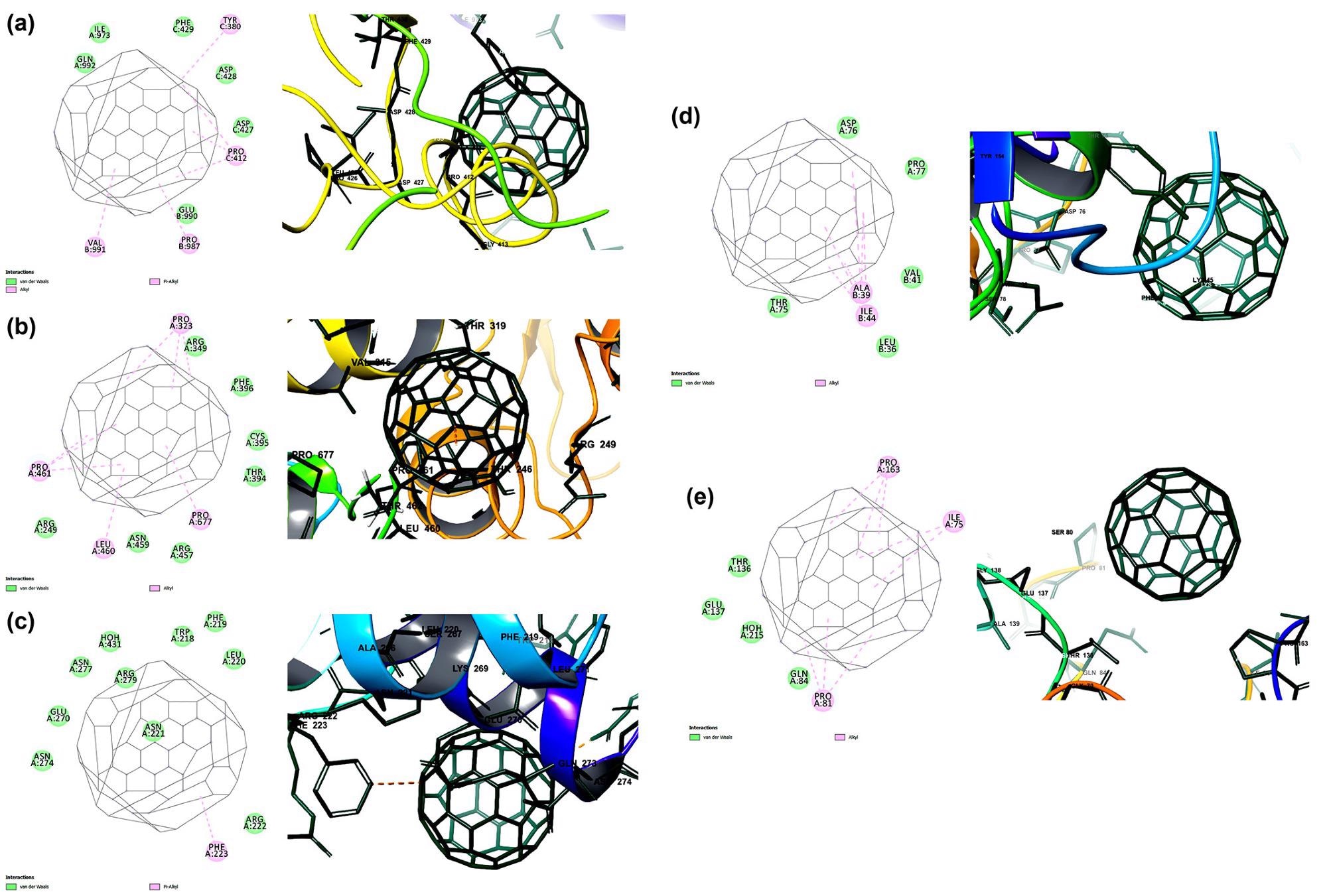
The binding potential of carbon nanofullerene towards the prioritized targets of SARS-CoV-2 is predicted by molecular docking. The binding affinity and interactions of carbon nano fullerene towards (a) spike glycoprotein (−13.7 kcal/mol), (b) RNA dependent RNA polymerase (−12.9 kcal/mol), (c) main protease (−11.4 kcal/mol), (d) papain-like protease (−10.6 kcal/mol) and (d) RNA binding domain of nucleocapsid protein (−10.1 kcal/mol). Image Credit: Skariyachan, S. et al
Nanotechnology and Computational Biology
Modern developments in nanotechnology have revealed the possibility of using nanoparticles such as CNTs and nano-fullerenes to target various areas of SARS-CoV-2, blocking its pathogenic effects. Carbon nanotubes are being touted as potential therapeutic materials owing to excellent mechanical capabilities, structural soundness, and tunability of functional groups.
Nanomaterials may be used to create nano-based COVID-19 protective devices and disinfectants. Furthermore, nanoparticles could be employed to function as antigen carriers or serve as an adjuvant medication for use concurrently with the upcoming COVID-19 vaccines.
The team used computation-based virtual screening and MD simulations to determine the binding capability of carbon nanotubes and nano-fullerenes to numerous putative target areas of the virus. Carbon nano-fullerenes have a potential affinity for SARS-CoV-2 targets, and carbon nanotubes have demonstrated possible interactions that might limit the virus’s harmful mechanism.
Identifying Structural Properties of Recognized Targets
Spike glycoproteins are the principal target of antibodies and are important in stimulating entrance into cells through the transmembrane spike. The transmembrane spike is composed of two functional subunits that are in charge of attaching to receptors of host cells and fusing the membranes of the virus and cells.
Each virus may identify distinct places of attachment and entrance by connecting with specific areas of the receptors in the host cell unit, depending on the type of viral strain. The major constituent of the viral machinery is responsible for replication and transcription; the RNA-dependent RNA polymerase (RdRp) is required for the survival of these viruses. Treatments targeting this area would be an excellent strategy.
The primary protease is an enzyme that is also involved in viral replication and transcription. The major protease is required for the digestion of viral RNA-translated polyproteins. Inhibiting this enzyme may aid in the prevention of viral replication. As a result, these proteins were chosen in the study because they might be potential therapeutic targets for SARS-CoV-2 infection.
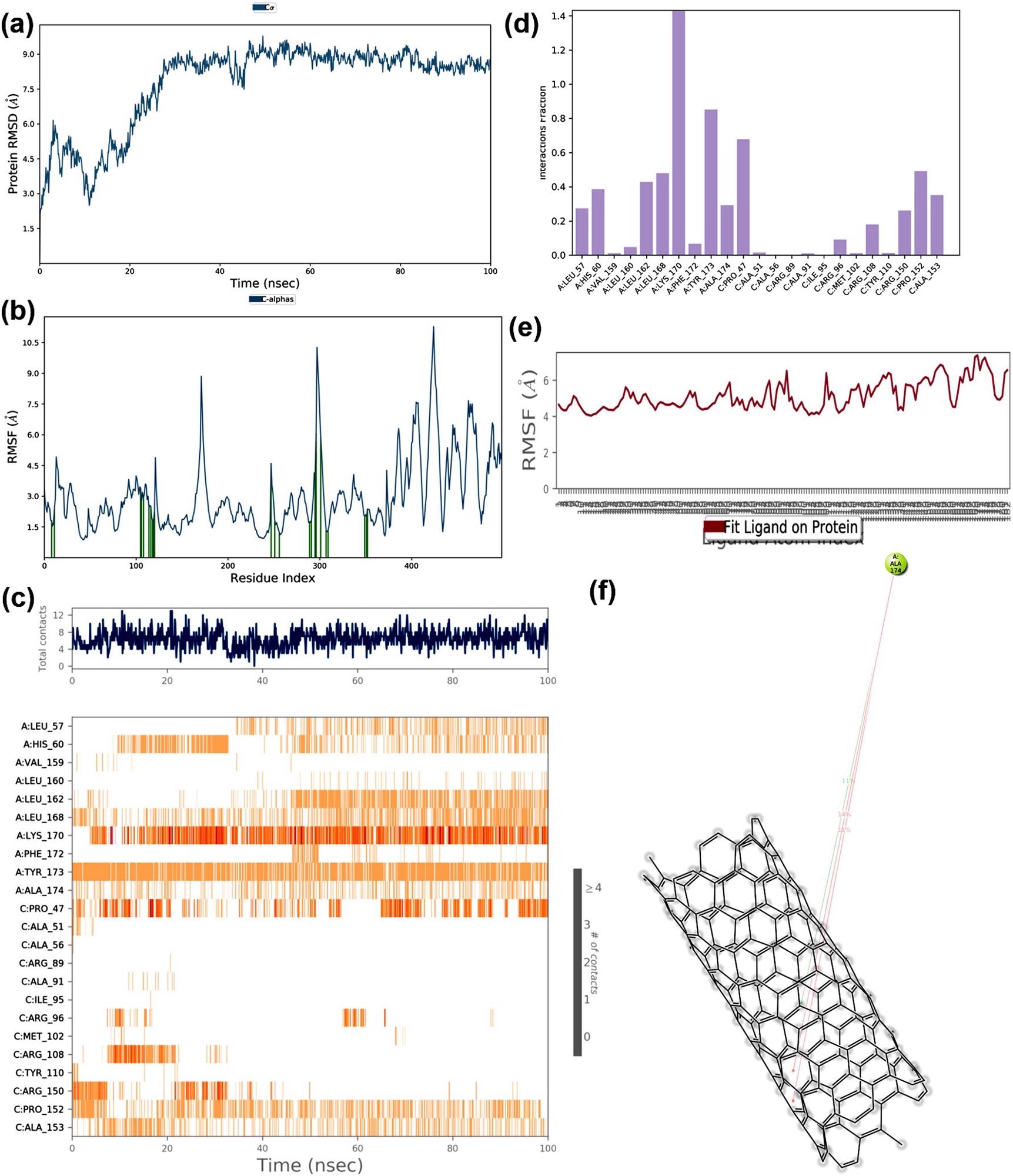
The MD simulation trajectories of RNA binding domain of the nucleocapsid protein and nano tube complex (a) RMSD: Protein RMSD (Å) on the y-axis and time on the x-axis (b) Protein RMSF (Å) on the y-axis and residues on the x-axis (c) Protein-ligand contacts over the simulation course, (d) histogram representing interaction fraction on the y-axis and residues on the x-axis (e) Ligand RMSF (Å) on the y-axis and atoms on the x-axis and (f) Major interactions that occur during MD simulation. Image Credit: Skariyachan, S. et al
Conclusions
It may initially seem unimpressive that the targets adopt this orientation only after adsorption on hydrophobic surfaces. However, there is potential for various orientations concerning the adsorption process on hydrophobic or charged areas. Therefore, understanding the interaction modeling of many orientations is critical.
The present research lays the groundwork for future laboratory tests and exploratory trials. Despite the nanoparticles’ apparent toxic nature, they might be employed as possible leads for blocking the coronavirus target areas. Research has shown the success of their use in target-specified treatments, drug transportation processes, cancer-related therapies, and other applications.
The MD simulation tests indicated that the priority entities and nanoparticles undergo dynamic interactions, which are steady and promising. When compared to carbon-fullerenes, nanotubes have the higher binding energy of the two carbon nanoparticles.
News
GLP-1 Drugs Like Ozempic Work, but New Research Reveals a Major Catch
Three new Cochrane reviews find evidence that GLP-1 drugs lead to clinically meaningful weight loss, though industry-funded studies raise concerns. Three new reviews from Cochrane have found that GLP-1 medications can lead to significant [...]
How a Palm-Sized Laser Could Change Medicine and Manufacturing
Researchers have developed an innovative and versatile system designed for a new generation of short-pulse lasers. Lasers that produce extremely short bursts of light are known for their remarkable precision, making them indispensable tools [...]
New nanoparticles stimulate the immune system to attack ovarian tumors
Cancer immunotherapy, which uses drugs that stimulate the body’s immune cells to attack tumors, is a promising approach to treating many types of cancer. However, it doesn’t work well for some tumors, including ovarian [...]
New Drug Kills Cancer 20,000x More Effectively With No Detectable Side Effects
By restructuring a common chemotherapy drug, scientists increased its potency by 20,000 times. In a significant step forward for cancer therapy, researchers at Northwestern University have redesigned the molecular structure of a well-known chemotherapy drug, greatly [...]
Lipid nanoparticles discovered that can deliver mRNA directly into heart muscle cells
Cardiovascular disease continues to be the leading cause of death worldwide. But advances in heart-failure therapeutics have stalled, largely due to the difficulty of delivering treatments at the cellular level. Now, a UC Berkeley-led [...]
The basic mechanisms of visual attention emerged over 500 million years ago, study suggests
The brain does not need its sophisticated cortex to interpret the visual world. A new study published in PLOS Biology demonstrates that a much older structure, the superior colliculus, contains the necessary circuitry to perform the [...]
AI Is Overheating. This New Technology Could Be the Fix
Engineers have developed a passive evaporative cooling membrane that dramatically improves heat removal for electronics and data centers Engineers at the University of California San Diego have created an innovative cooling system designed to greatly enhance [...]
New nanomedicine wipes out leukemia in animal study
In a promising advance for cancer treatment, Northwestern University scientists have re-engineered the molecular structure of a common chemotherapy drug, making it dramatically more soluble and effective and less toxic. In the new study, [...]
Mystery Solved: Scientists Find Cause for Unexplained, Deadly Diseases
A study reveals that a protein called RPA is essential for maintaining chromosome stability by stimulating telomerase. New findings from the University of Wisconsin-Madison suggest that problems with a key protein that helps preserve chromosome stability [...]
Nanotech Blocks Infection and Speed Up Chronic Wound Recovery
A new nanotech-based formulation using quercetin and omega-3 fatty acids shows promise in halting bacterial biofilms and boosting skin cell repair. Scientists have developed a nanotechnology-based treatment to fight bacterial biofilms in wound infections. The [...]
Researchers propose five key questions for effective adoption of AI in clinical practice
While Artificial Intelligence (AI) can be a powerful tool that physicians can use to help diagnose their patients and has great potential to improve accuracy, efficiency and patient safety, it has its drawbacks. It [...]
Advancements and clinical translation of intelligent nanodrugs for breast cancer treatment
A comprehensive review in "Biofunct. Mater." meticulously details the most recent advancements and clinical translation of intelligent nanodrugs for breast cancer treatment. This paper presents an exhaustive overview of subtype-specific nanostrategies, the clinical benefits [...]
It’s Not “All in Your Head”: Scientists Develop Revolutionary Blood Test for Chronic Fatigue Syndrome
A 96% accurate blood test for ME/CFS could transform diagnosis and pave the way for future long COVID detection. Researchers from the University of East Anglia and Oxford Biodynamics have created a highly accurate [...]
How Far Can the Body Go? Scientists Find the Ultimate Limit of Human Endurance
Even the most elite endurance athletes can’t outrun biology. A new study finds that humans hit a metabolic ceiling at about 2.5 times their resting energy burn. When ultra-runners take on races that last [...]
World’s Rivers “Overdosing” on Human Antibiotics, Study Finds
Researchers estimate that approximately 8,500 tons of antibiotics enter river systems each year after passing through the human body and wastewater treatment processes. Rivers spanning millions of kilometers across the globe are contaminated with [...]
Yale Scientists Solve a Century-Old Brain Wave Mystery
Yale scientists traced gamma brain waves to thalamus-cortex interactions. The discovery could reveal how brain rhythms shape perception and disease. For more than a century, scientists have observed rhythmic waves of synchronized neuronal activity [...]
